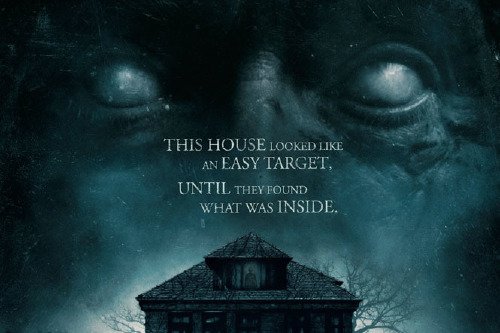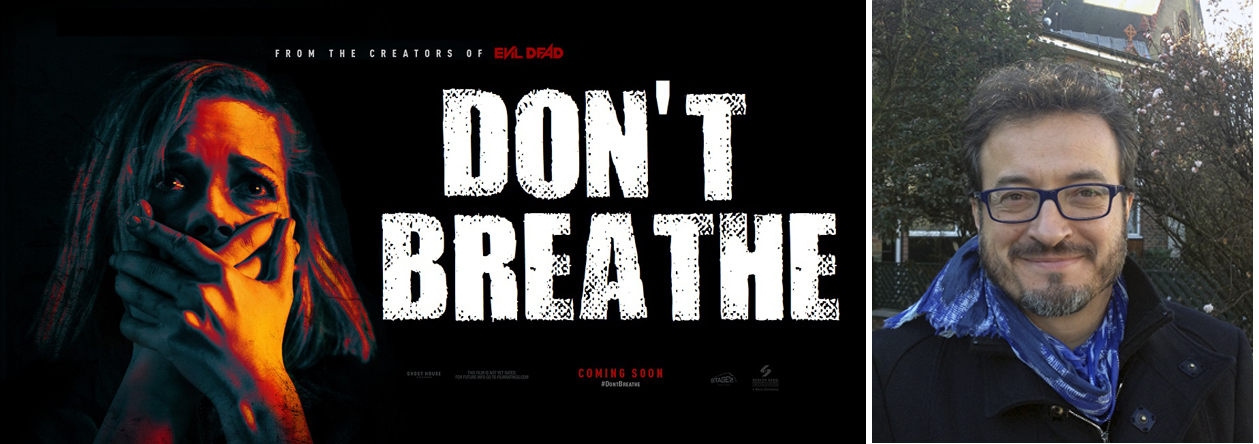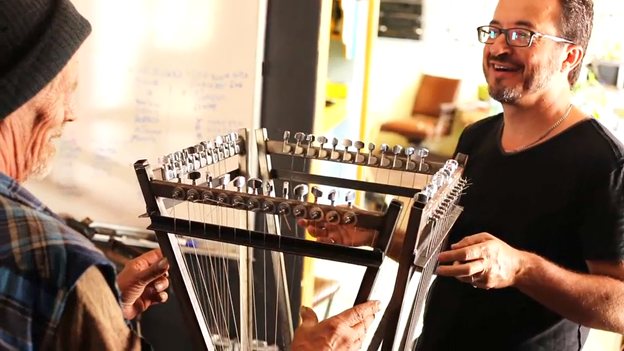Roque Baños Scores with DON’T BREATHE
Interview by Randall D. Larson, August 2016
Renowned Spanish film composer Roque Baños (IN THE HEART OF THE SEA, THE MACHINIST, OLD BOY) has scored the new horror/thriller DON’T BREATHE, directed by Fede Alvarez. Baños previously collaborated with Alvarez on the director’s update of the Sam Raimi classic EVIL DEAD, for which he won two 2013 International Film Music Critics Awards: “Best Original Score for a Fantasy/Science Fiction/Horror Film” and “Film Music Composition of the Year.”
DON’T BREATHE takes place almost entirely inside a house, as would-be robbers are confronted by its unexpectedly fierce owner. For such an intensely claustrophobic story, Baños decided to make “the house play the music,” by using ordinary household objects or materials as instruments for the score. This clever technique intensifies the fear factor, as familiar sounds become sinister when used out of context. Tucson-based Anarchestra performed the music by striking metal surfaces such as pipes and cans with a hammer, bending and cutting wires, bowing saws, snapping bolt cutters and even banging against gas tanks. For emotional moments, Baños added piano, the sole traditional instrument in the score. In this way, the film’s music melds seamlessly with its eerie sound effects.
Baños used a similar approach of incorporating the setting into the score for Ron Howard’s epic drama, IN THE HEART OF THE SEA, in which he used sounds from the ship, sails, and harpoons alongside traditional instruments. (See my interview with Baños about IN THE HEART OF THE SEA, RISEN, EVIL DEAD, and other scores here.)
Q: How did you enjoy returning to work with Fede Alvarez, your director on EVIL DEAD, on his new horror thriller DON’T BREATHE?
Roque Baños: This time had been very much easier. I don’t want to say that the other one was difficult – with Fede I always had really good communication and we’ve been very comfortable working together. But in this one we wanted to try something very different from what we did in EVIL DEAD. We both wanted to create a score that was completely unusual.
Q: When you first sat with Fede to spot the film, how did you come up with the idea of incorporating the sounds of household objects as your primary sonic palette for this horror films musical accompaniment?
Roque Baños: We thought that it could be really interesting that the house itself was singing the music for these people locked inside itself. We thought that if the house could have its own voice through the score, it would make a sense of more horror and more claustrophobia. The old house was making the music, which we felt could be very horrifying.
Q: How did you use that sonic palette to delineate that kind of situation?
Roque Baños: If it’s not like a classic instrumentation as it’s been used for so many years with the orchestra or other electronic instruments, there can be other types of instruments. I’ve used them similarly to how I was using a normal orchestra, for example, to make this blind man a more powerful in DON’T BREATHE. I made drones from these sounds, but they were very low, which makes it scarier. And then for the robbers – the kids – they were so frightened by this man and they were trying to survive inside that house, so I used more high pitched instruments and rhythmic material to be able to show their anxiety and their desire to escape.

Q: You brought in the Arizona-based avant-garde band Anarchestra to perform your utensil orchestra. How did you discover them and how did you work with them to achieve the kind of apprehension you wanted for this score?
Roque Baños: This was one of the fun parts of making this score. I met with the guy who had created the Anarchestra, Alex Ferris, an amazing guy who has spent many, many years building these instruments out of any kind of trash that he can find, like washing machines, cars, gas tanks… whatever! The thing I liked about it is that these instruments make an acoustic sound – it’s not a synth-generated sound, it’s is acoustic, which is real. That was just what I needed for this score, because that was the closest I could get to finding how this house would make music. We spent a whole week experimenting with each one of his instruments and making sounds, so then I could build a library of sound that later on I wo9uld use to make the score. After the score was completed, I went back there and we played some of the cues live, and that was an amazing experience.
Watch video: Roque Baños plays with Alex Ferris and Edu Cruz of Anarchestra some music from the movie DON’T BREATHE.
Q: I saw that youtube clip of you playing with Alex and Edu on those percussive of instruments. It reminded me of what you did in IN THE HEART OF THE SEA where you had the wooden sounds of the ship become part of the texture of the orchestra. The audience may not realize what those sounds are but when they hear them it lends a perhaps subliminal acoustic resonance to how the music impacts what they’re watching.
Roque Baños: Yes, absolutely. I’ve been composing film scores for the last twenty years and after seventy scores of using the usual orchestra mix, this is a new way that I am discovering, and I am enjoying it a lot. It’s like focusing on what we’re seeing on the screen and asking how we can make music from that! When I’m doing that, I find the music is really integrated in the movie; it’s part of what you see.
Q: Are you using these specialized sounds in a percussive way or have you also modified them electronically to achieve the film’s full score?
Roque Baños: It’s not only made in a percussive way. I was able to make some drums and pitches so that I could use those to make the themes. Actually, in this score we are providing themes, too, so when you hear it you can identify that there are a couple of melodies that, they are played by these instruments as well, so I could make also tones out of these sounds.
 Q: What was most challenging about scoring DON’T BREATHE?
Q: What was most challenging about scoring DON’T BREATHE?
Roque Baños: The most challenging thing no doubt was to create a score that made sense out of all this. That was the biggest one! When I had this huge library that I brought from Tucson, I was like, oh my God, how can I make a score out of all this?! At first I was very scared, I was thinking that wouldn’t be possible!
Q: So when you were back in your studio in Los Angeles with those recordings, what was your process of transferring the acoustic sounds into your studio equipment to create the final score?
Roque Baños: There are multiple ways of converting those sounds into notes and being able to play music with it. In general, I put all the sounds into my sampler and assigned them to different instruments so that I could switch from one to another in my sequencer. That gave my keyboard the sounds of each instrument, so then I could play them as if I was playing the piano. I would manipulate the sounds until I got the tone I wanted, and then I would extend that so I had the different notes. I also created some looping sounds that make a groove.
Q: Any final comments about your experience in scoring DON’T BREATHE?
Roque Baños: I think this movie is going to be big breakout for Fede Alvarez as a director. He’s an amazing director and we will see that in this movie.
Watch the trailer for DON’T BREATHE here:
Special thanks to Ray Costa & Olivia Taaffe of Costa Communications for facilitating this interview.







